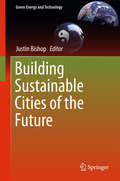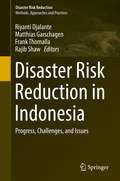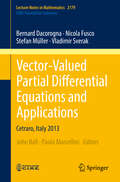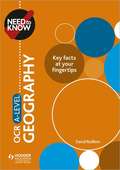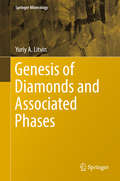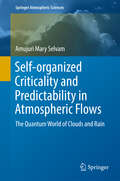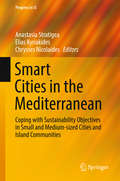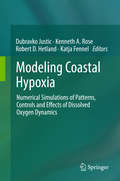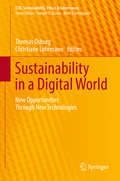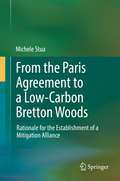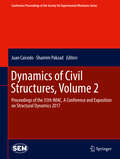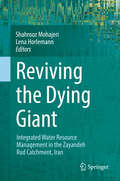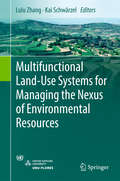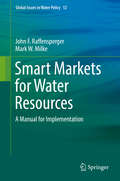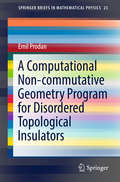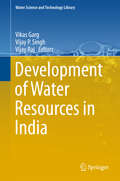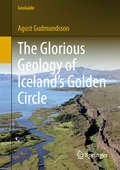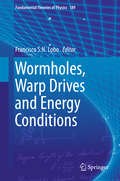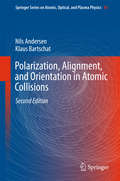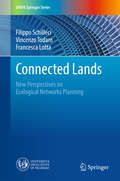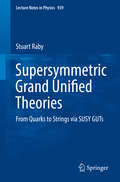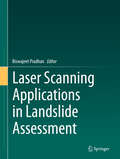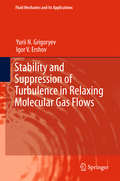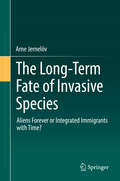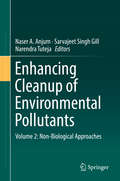- Table View
- List View
Building Sustainable Cities of the Future (Green Energy and Technology)
by Justin BishopThis book draws upon the expertise of academic researchers, urban planners and architects to explore the challenge of building the sustainable cities of the future. It addresses this challenge by considering current cities and those of the near future, and creates a picture of the sustainable city from the bottom up.Individual chapters cover topics such as transport, energy supply, sustainable urbanism and promoting social equality in large infrastructure projects. Real-world examples are presented to illustrate how systems thinking is used to integrate different components of a city so as to ensure that the whole is more sustainable than its parts.Written in an accessible style, this book is intended for general readers as much as it is for students and researchers interested in sustainable cities and related topics. It is also ideal for urban planners seeking best-practice guidelines for sustainable urban development.
Disaster Risk Reduction in Indonesia: Progress, Challenges, and Issues (Disaster Risk Reduction)
by Riyanti Djalante Matthias Garschagen Frank Thomalla Rajib ShawThis book is a unique, transdisciplinary summary of the state of the art of disaster risk reduction (DRR) in Indonesia. It provides a comprehensive overview of disaster risk governance across all levels and multiple actors including diverse perspectives from practitioners and researchers on the challenges and progress of DRR in Indonesia. The book includes novel and emerging topics such as the role of culture, religion, psychology and the media in DRR. It is essential reading for students, researchers, and policy makers seeking to understand the nature and variety of environmental hazards and risk patterns affecting Indonesia.Following the introduction, the book has four main parts of key discussions. Part I presents disaster risk governance from national to local level and its integration into development sectors, Part II focuses on the roles of different actors for DRR, Part III discusses emerging issues in DRR research and practice, and Part IV puts forward variety of methods and studies to measure hazards, risks and community resilience.
Vector-Valued Partial Differential Equations and Applications: Cetraro, Italy 2013 (Lecture Notes in Mathematics #2179)
by John Ball Paolo Marcellini Bernard Dacorogna Nicola Fusco Stefan Müller Vladimir SverakCollating different aspects of Vector-valued Partial Differential Equations and Applications, this volume is based on the 2013 CIME Course with the same name which took place at Cetraro, Italy, under the scientific direction of John Ball and Paolo Marcellini. It contains the following contributions: The pullback equation (Bernard Dacorogna), The stability of the isoperimetric inequality (Nicola Fusco), Mathematical problems in thin elastic sheets: scaling limits, packing, crumpling and singularities (Stefan Müller), and Aspects of PDEs related to fluid flows (Vladimir Sverák). These lectures are addressed to graduate students and researchers in the field.
Need to Know: OCR A-level Geography
by David RedfernExam board: OCRLevel: A-levelSubject: GeographyFirst teaching: September 2016First exams: Summer 2017 (AS); Summer 2018 (A-level)Find what you need to know, when you need it, with key facts at your fingertips for OCR A-level Geography.Keep this course companion by your side throughout your A-levels so you can check content, review your understanding, use quick tips for success and improve your exam performance.Written by an experienced teacher, author and former Chief Examiner, this book will help you to:- Build on your learning throughout the course by reinforcing the key facts, terms and concepts from the OCR A-level Geography specification- Answer exam questions more effectively with tips on exam technique, mistakes to avoid and important things to remember- Revise with confidence using 'Do you know?' questions at the end of each topic and more in-depth questions at the end of each sectionThis book covers the following topics:Physical systems- Landscape Systems - Option A: Coastal Landscapes- Earth's Life Support SystemsHuman interactions- Changing Spaces; Making Places- Global Connections - Global Systems Option B: Global Migration- Global Connections - Global Governance Option D: Power and Borders Geographical debates- Disease Dilemmas- Hazardous Earth
Genesis of Diamonds and Associated Phases (Springer Mineralogy)
by Yuriy A. LitvinThis book presents an overview of recent advances in our understanding of the genesis of diamonds and the associated phases. It is divided into three main parts, starting with an introduction to the analysis of diamond inclusions to infer the formation processes. In turn, the second part of the book presents high-pressure experimental studies in mantle diamond-parental mineral systems with representative multicomponent boundary compositions. The experimental syngenesis phase diagrams provided reveal the physicochemical mechanisms of diamond nucleation and substantiate the mantle-carbonatite concept of the genesis of diamonds and associated phases. Lastly, the book describes the genetic classification of diamond-hosted mineral inclusions and experimentally determined RE “mineral-parental melt” partition coefficients. The physicochemical experimental evidence presented shows the driving forces behind the fractional evolution of the mantle magmas and diamond-parental melts.Given the depth and breadth of its coverage, the book offers researchers essential new insights into the ways diamonds and associated minerals and rocks are naturally created.
Self-organized Criticality and Predictability in Atmospheric Flows: The Quantum World of Clouds and Rain (Springer Atmospheric Sciences)
by Amujuri Mary SelvamThis book presents a new concept of General Systems Theory and its application to atmospheric physics. It reveals that energy input into the atmospheric eddy continuum, whether natural or manmade, results in enhancement of fluctuations of all scales, manifested immediately in the intensification of high-frequency fluctuations such as the Quasi-Biennial Oscillation and the El-Nino–Southern Oscillation cycles. Atmospheric flows exhibit self-organised criticality, i.e. long-range correlations in space and time manifested as fractal geometry to the spatial pattern concomitant with an inverse power law form for fluctuations of meteorological parameters such as temperature, pressure etc. Traditional meteorological theory cannot satisfactorily explain the observed self-similar space time structure of atmospheric flows. A recently developed general systems theory for fractal space-time fluctuations shows that the larger-scale fluctuation can be visualised to emerge from the space-time averaging of enclosed small-scale fluctuations, thereby generating a hierarchy of self-similar fluctuations manifested as the observed eddy continuum in power spectral analyses of fractal fluctuations. The interconnected network of eddy circulations responds as a unified whole to local perturbations such as global-scale response to El-Nino events. The general systems theory model predicts an inverse power law form incorporating the golden mean τ for the distribution of space-time fluctuation patterns and for the power (variance) spectra of the fluctuations. Since the probability distributions of amplitude and variance are the same, atmospheric flows exhibit quantumlike chaos. Long-range correlations inherent to power law distributions of fluctuations are identified as nonlocal connection or entanglement exhibited by quantum systems such as electrons or photons. The predicted distribution is close to the Gaussian distribution for small-scale fluctuations, but exhibits a fat long tail for large-scale fluctuations. Universal inverse power law for fractal fluctuations rules out unambiguously linear secular trends in climate parameters.
Smart Cities in the Mediterranean: Coping with Sustainability Objectives in Small and Medium-sized Cities and Island Communities (Progress in IS)
by Anastasia Stratigea Elias Kyriakides Chrysses NicolaidesThis book sheds new light on the current and future challenges faced by cities, and presents approaches, options and solutions enabled by Information and Communication Technologies (ICT) in the smart city context. By focusing on sustainability objectives within a rapidly changing social, economic, environmental and technological setting, it explores a variety of planning challenges faced by contemporary cities and the power of smart city developments in terms of providing innovative tools, approaches, methodologies and technologies to help cities cope with these challenges. Key issues addressed include smart city (e-) planning and (e-)participation; smart data management to facilitate decision-making processes in cities and insular communities on a variety of topics; smart and sustainable management aspects of climate change, water scarcity, mobility, energy, infrastructure, tourism, blue growth, risk assessment; etc. The book presents current and potential pathways and applications for the evolution of smart cities and communities, taking into consideration the unique problems and opportunities emanating from their specific geographical location. The case study examples mainly concern small and medium-sized cities and communities as well as insular areas in the Mediterranean region, while also incorporating lessons learned from other parts of the world. Their focus is on the specific opportunities and threats emerging in these urban and insular environments, which are characterized by their role as globally known tourist destinations, their coastal or port character, and unique cultural resources, as well as the high rated vulnerability in very many sustainability respects (social, economic, biodiversity, urbanization, migration, poverty, etc.) to be found in the Mediterranean region at large
Modeling Coastal Hypoxia: Numerical Simulations of Patterns, Controls and Effects of Dissolved Oxygen Dynamics
by Dubravko Justic Kenneth A. Rose Robert D. Hetland Katja FennelThis book provides a snapshot of representative modeling analyses of coastal hypoxia and its effects. Hypoxia refers to conditions in the water column where dissolved oxygen falls below levels that can support most metazoan marine life (i.e., 2 mg O2 l-1). The number of hypoxic zones has been increasing at an exponential rate since the 1960s; there are currently more than 600 documented hypoxic zones in the estuarine and coastal waters worldwide. Hypoxia develops as a synergistic product of many physical and biological factors that affect the balance of dissolved oxygen in seawater, including temperature, solar radiation, wind, freshwater discharge, nutrient supply, and the production and decay of organic matter. A number of modeling approaches have been increasingly used in hypoxia research, along with the more traditional observational and experimental studies. Modeling is necessary because of rapidly changing coastal circulation and stratification patterns that affect hypoxia, the large spatial extent over which hypoxia develops, and limitations on our capabilities to directly measure hypoxia over large spatial and temporal scales. This book consists of 15 chapters that are broadly organized around three main topics: (1) Modeling of the physical controls on hypoxia, (2) Modeling of biogeochemical controls and feedbacks, and, (3) Modeling of the ecological effects of hypoxia. The final chapter is a synthesis chapter that draws generalities from the earlier chapters, highlights strengths and weaknesses of the current state-of-the-art modeling, and offers recommendations on future directions.
Sustainability in a Digital World: New Opportunities Through New Technologies (CSR, Sustainability, Ethics & Governance)
by Thomas Osburg Christiane LohrmannThis book offers a comprehensive introduction to the different emerging concepts in the innovative area of sustainability and digital technology. More than 20 leading thinkers from the fields of digitalization, strategic management, sustainability and organizational development share clearly structured insights on the latest developments, advances and remaining challenges concerning the role of sustainability in an increasingly digital world. The authors not only introduce a profound and unique analysis on the state-of-the art of sustainability and digital transformation, but also provide business leaders with practical advice on how to apply the latest management thinking to their daily business decisions. Further, a number of significant case studies exemplify the issues discussed and serve as valuable blueprints for decision makers.
From the Paris Agreement to a Low-Carbon Bretton Woods: Rationale for the Establishment of a Mitigation Alliance
by Michele StuaThis book investigates the existing and possible links between the concept of a Carbon Club and the Paris Agreement. In doing so the book defines those criteria that may lead to an effective establishment of a Carbon Club acting within the mandate of the Paris Agreement and identifies the key questions that such an option may help to tackle: Which low-carbon pathways are compatible with the new temperature targets set by the Paris Agreement? Can new entities like the Carbon Club have a decisive role in guaranteeing the alignment of the aggregate mitigating actions with the global objectives identified within the Paris Agreement? What role will be played by market and non-market approaches within the proposed framework? How can economic, social, and environmental sustainability be ensured during the implementation of the Agreement? How can justice and equity be encouraged between the Parties and all the involved actors as required by the Agreement? Which instruments can be designed and adopted to provide the expected degree of transparency for the new system? To respond to these questions the book adopts a holistic approach, able to emphasize the strong interrelations. The book discusses the opportunity to develop a Carbon Club within the Article 6 framework, and provides a feasible roadmap for its means of implementation, rules and governance structure. The final result is a feasible policy proposal that takes into account all the key issues introduced by the questions, and draws a roadmap towards a 'low-carbon Bretton Woods’.
Dynamics of Civil Structures, Volume 2: Proceedings of the 35th IMAC, A Conference and Exposition on Structural Dynamics 2017 (Conference Proceedings of the Society for Experimental Mechanics Series)
by Juan Caicedo Shamim PakzadDynamics of Civil Structures, Volume 2: Proceedings of the 35th IMAC, A Conference and Exposition on Structural Dynamics, 2017, the second volume of ten from the Conference brings together contributions to this important area of research and engineering. The collection presents early findings and case studies on fundamental and applied aspects of the Dynamics of Civil Structures, including papers on: Modal Parameter Identification Dynamic Testing of Civil Structures Control of Human Induced Vibrations of Civil Structures Model Updating Damage Identification in Civil Infrastructure Bridge Dynamics Experimental Techniques for Civil Structures Hybrid Simulation of Civil Structures Vibration Control of Civil Structures System Identification of Civil Structures
Reviving the Dying Giant: Integrated Water Resource Management in the Zayandeh Rud Catchment, Iran
by Shahrooz Mohajeri Lena HorlemannThis book presents the results of an interdisciplinary research project that was set up to introduce Integrated Water Resources Management (IWRM) at the Zayandeh Rud, Central Iran’s most important river. As a result of climate change and a missing overall concept for sustainably managing water resources, the river has repeatedly dried up in recent years. Not only has water stress led to severe conflicts among the water using sectors and neighboring provinces, it also threatens important ecosystems in the region. Thus, the joint development of an IWRM concept for the Zayandeh Rud catchment was the main objective of the project. Comprehensive technological and non-technological measures – ranging from wastewater reuse to capacity development – were adjusted to local conditions and implemented in order to initiate an integrated, iterative IWRM process. The design of a technology-based Water Management Tool (WMT) served as the connective link to create trust, cooperation and coordination among the stakeholders and institutions.
Multifunctional Land-Use Systems for Managing the Nexus of Environmental Resources
by Lulu Zhang Kai SchwärzelThis book comprehensively describes the major ecosystem services in dryland environments that are provided by typical land use, including forestland, grassland and farmland, using the Loess Plateau, Northwest China as an example. It offers extensive information on land policy, implementation and scientific evidence, and discusses the restoration of the degraded Loess Plateau environment, which that brings new challenges in the sustainable use of natural resources, in particular soil and water. It presents a transdisciplinary and up-to-date understanding of interlinkages and competition between different ecosystem services and illustrates benefit sharing among different users and stakeholders, land- management practitioners and local governments. It is a major contribution to the on-going debate on future land-development strategies and identifies areas where there is a need for more research. This book is a valuable resource for students, scientists and policy makers.
Smart Markets for Water Resources: A Manual for Implementation (Global Issues in Water Policy #12)
by John F. Raffensperger Mark W. MilkeWhy is trade in wholesale water so rare, when markets can actively trade bread, tractors, and electricity? This book shows that water markets fail because of high transaction costs, resulting in inefficient allocations and unpredictable environmental effects. To overcome these obstacles, this book proposes a trading mechanism called a smart market. A smart market is an auction cleared with optimization. A smart market can reduce the transaction costs of water trading, while improving the environmental outcomes. The authors show why a smart market for water is needed, how it would work, and how to implement it. The smart market described here uses a hydrology simulation of the water resource, user bids via the internet, and mathematical optimization, to maximize the economic value of water while meeting all environmental constraints. The book provides the background to understand the smart market for water, and the detail to help the reader start working on its application. The book explores topics such as:Why water should be more expensive near sensitive environmental locations,Ways to set initial allocations of water rights,The role of regulatory oversight,The prerequisites of a water market, andHow to counter objections to water markets. The culmination of a decade of investigation, this book combines explanation, examples, and detail to inform policymakers, large water users, environmental organizations, researchers, and a thirsty public.
A Computational Non-commutative Geometry Program for Disordered Topological Insulators (SpringerBriefs in Mathematical Physics #23)
by Emil ProdanThis work presents a computational program based on the principles of non-commutative geometry and showcases several applications to topological insulators. Noncommutative geometry has been originally proposed by Jean Bellissard as a theoretical framework for the investigation of homogeneous condensed matter systems. Recently, this approach has been successfully applied to topological insulators, where it facilitated many rigorous results concerning the stability of the topological invariants against disorder.In the first part of the book the notion of a homogeneous material is introduced and the class of disordered crystals defined together with the classification table, which conjectures all topological phases from this class. The manuscript continues with a discussion of electrons’ dynamics in disordered crystals and the theory of topological invariants in the presence of strong disorder is briefly reviewed. It is shown how all this can be captured in the language of noncommutative geometry using the concept of non-commutative Brillouin torus, and a list of known formulas for various physical response functions is presented. In the second part, auxiliary algebras are introduced and a canonical finite-volume approximation of the non-commutative Brillouin torus is developed. Explicit numerical algorithms for computing generic correlation functions are discussed. In the third part upper bounds on the numerical errors are derived and it is proved that the canonical-finite volume approximation converges extremely fast to the thermodynamic limit. Convergence tests and various applications concludes the presentation.The book is intended for graduate students and researchers in numerical and mathematical physics.
Development of Water Resources in India (Water Science and Technology Library #75)
by Vikas Garg Vijay P. Singh Vijay RajThis proceedings volume, with more than 30 chapters, is based on the presentations given at the National Conference on Water Resources and Hydropower (WRHP-2016) and represents the state-of-the-art in water resources in India. It includes experimental investigations, field studies, theoretical developments, numerical methods, as well as engineering achievements in water resources. The contributions are organised under four main topics: • Water Resources and Management: covers the issues related to water resources planning and management, water conservation, flood mitigation, policies and governance, conflict over rivers and planning of groundwater evolution, Assessment of Sedimentation, Surface water quality, Rainfall assessment, • Climate Change and Global Warming: includes chapters on the impact of climate on water resources and groundwater, hydrological impacts of climate change, Ground Water Contaminants, Assessment of Evaporation and evapotranspiration effects on global warming• Hydraulic Structures: presents contributions on fluvial hydraulics,flow through Weirs, Open Channel flow, river flood control, scour and erosion, dam and dowstream block failures and protection, Losses in pipes By combining these topics, the book provides a valuable resource for practitioners and researchers, including field engineers, academicians, planners, health specialists, disaster managers, decision makers and policy makers engaged in various aspects of water resources and hydropower. The WRHP-2016 was organised in association with the Indian Institute of Technology, Roorkee, Uttrakhand Jal Vidyut Nigam Limited and the Indian Society for Hydraulics, Pune and was held in University of Petroleum and Energy Studies, Dehradun, India from June 17-18, 2016.
The Glorious Geology of Iceland's Golden Circle (GeoGuide)
by Agust GudmundssonThis is the first book describing the glorious geology of Iceland’s Golden Circle and four additional excursions:(1) the beautiful valleys and mountains of the fjord of Hvalfjördur, (2) the unique landscape and geothermal fields of the Hengill Volcano, (3) the explosion craters, volcanic fissures, and lava fields of the Reykjanes Peninsula, and (4) the volcanoes (Hekla, Eyjafjallajökull, Katla), waterfalls, sandur plains, and rock columns of South Iceland. The Golden Circle offers a unique opportunity to observe and understand many of our planet’s forces in action. These forces move the Earth’s tectonic plates, rupture the crust, and generate earthquakes, volcanic eruptions, channels for rivers and waterfalls, and heat sources for hot springs and geysers. The Golden Circle includes the famous rifting and earthquake fracture sites at Thingvellir, the hot springs of the Geysir area, the waterfall of Gullfoss, and the Kerid volcanic crater. As the book is primarily intended for people with no background in geosciences, no geological knowledge is assumed and technical terms are avoided as far as possible (those used are explained in a glossary). With more than 240 illustrations – mostly photographs – explaining geological structures and processes, it is also a useful resource for geoscientists.
Wormholes, Warp Drives and Energy Conditions (Fundamental Theories of Physics #189)
by Francisco S. LoboTop researchers in the field of gravitation present the state-of-the-art topics outlined in this book, ranging from the stability of rotating wormholes solutions supported by ghost scalar fields, modified gravity applied to wormholes, the study of novel semi-classical and nonlinear energy conditions, to the applications of quantum effects and the superluminal version of the warp drive in modified spacetime. Based on Einstein's field equations, this cutting-edge research area explores the more far-fetched theoretical outcomes of General Relativity and relates them to quantum field theory. This includes quantum energy inequalities, flux energy conditions, and wormhole curvature, and sheds light on not just the theoretical physics but also on the possible applications to warp drives and time travel.This book extensively explores the physical properties and characteristics of these 'exotic spacetimes,' describing in detail the general relativistic geometries that generate closed timelike curves.
Polarization, Alignment, and Orientation in Atomic Collisions (Springer Series on Atomic, Optical, and Plasma Physics #96)
by Nils Andersen Klaus BartschatThis book covers polarization, alignment, and orientation effects in atomic collisions induced by electron, heavy particle, or photon impact. The first part of the book presents introductory chapters on light and particle polarization, experimental and computational methods, and the density matrix and state multipole formalism. Examples and exercises are included. The second part of the book deals with case studies of electron impact and heavy particle excitation, electron transfer, impact ionization, and autoionization. A separate chapter on photo-induced processes by new-generation light sources has been added. The last chapter discusses related topics and applications. Part III includes examples of charge clouds and introductory summaries of selected seminal papers of tutorial value from the early history of the field (1925 – 1975).The book is a significant update to the previous (first) edition, particularly in experimental and computational methods, the inclusion of key results obtained during the past 15 years, and the extended coverage of photo-induced processes. It is intended as an introductory text for both experimental and theoretical students and researchers. It can be used as a textbook for graduate courses, as a primary source for special topics and seminar courses, and as a standard reference.The book is accompanied by electronically available copies of the full text of the key papers in Part III, as well as animations of theoretically predicted electron charge clouds and currents for some of the cases discussed in Part II.
Connected Lands: New Perspectives on Ecological Networks Planning (UNIPA Springer Series)
by Filippo Schilleci Vincenzo Todaro Francesca LottaThis book explores and outlines the reference theoretical basis of ecological networks within the international debate, focusing on how protected areas should no longer be considered as the sum of different components but rather as a network. The various European, transnational and national models of ecological networks/connections are analyzed on the basis of a detailed, updated study of relevant documents. The complex picture that emerges shows a wide range of reticular-ecological models within European plans and programs, but also many non-integrated experiences. The book subsequently examines the regulation of ecological networks/connections within planning instruments, explaining the critical points and referring to different ecological network models and specific local realities. Lastly, the book addresses two Italian case studies regarding the different normative and planning frameworks, both at a national and regional level, and demonstrating not only how ecological networks/connections can be structured within plans, but also how these networks/connections represent the core element of territory development and preservation. As such, it provides an essential tool for containing habitat fragmentation, offering a new perspective that integrates theoretical approaches and methods with planning models and the lessons learned from local applications.
Supersymmetric Grand Unified Theories: From Quarks to Strings via SUSY GUTs (Lecture Notes in Physics #939)
by Stuart RabyThese course-tested lectures provide a technical introduction to Supersymmetric Grand Unified Theories (SUSY GUTs), as well as a personal view on the topic by one of the pioneers in the field. While the Standard Model of Particle Physics is incredibly successful in describing the known universe it is, nevertheless, an incomplete theory with many free parameters and open issues. An elegant solution to all of these quandaries is the proposed theory of SUSY GUTs. In a GUT, quarks and leptons are related in a simple way by the unifying symmetry and their electric charges are quantized, further the relative strength of the strong, weak and electromagnetic forces are predicted. SUSY GUTs additionally provide a framework for understanding particle masses and offer candidates for dark matter. Finally, with the extension of SUSY GUTs to string theory, a quantum-mechanically consistent unification of the four known forces (including gravity) is obtained. The book is organized in three sections: the first section contains a brief introduction to the Standard Model, supersymmetry and the Minimal Supersymmetric Standard Model. Then SUSY GUTs in four space-time dimensions are introduced and reviewed. In addition, the cosmological issues concerning SUSY GUTs are discussed. Then the requirements for embedding a 4D SUSY GUT into higher-dimensional theories including gravity (i.e. String Theory) are investigated. Accordingly, section two of the course is devoted to discussing the so-called Orbifold GUTs and how in turn they solve some of the technical problems of 4D SUSY GUTs. Orbifold GUTs introduce a new set of open issues, which are then resolved in the third section in which it is shown how to embed Orbifold GUTs into the E(8) x E(8) Heterotic String in 10 space-time dimensions.
Laser Scanning Applications in Landslide Assessment
by Biswajeet PradhanThis book is related to various applications of laser scanning in landslide assessment. Landslide detection approaches, susceptibility, hazard, vulnerability assessment and various modeling techniques are presented. Optimization of landslide conditioning parameters and use of heuristic, statistical, data mining approaches, their advantages and their relationship with landslide risk assessment are discussed in detail. The book contains scanning data in tropical forests; its indicators, assessment, modeling and implementation. Additionally, debris flow modeling and analysis including source of debris flow identification and rockfall hazard assessment are also presented.
Stability and Suppression of Turbulence in Relaxing Molecular Gas Flows (Fluid Mechanics and Its Applications #117)
by Yurii N. Grigoryev Igor V. ErshovThis book presents an in-depth systematic investigation of a dissipative effect which manifests itself as the growth of hydrodynamic stability and suppression of turbulence in relaxing molecular gas flows. The work describes the theoretical foundations of a new way to control stability and laminar turbulent transitions in aerodynamic flows. It develops hydrodynamic models for describing thermal nonequilibrium gas flows which allow the consideration of suppression of inviscid acoustic waves in 2D shear flows. Then, nonlinear evolution of large-scale vortices and Kelvin-Helmholtz waves in relaxing shear flows are studied. Critical Reynolds numbers in supersonic Couette flows are calculated analytically and numerically within the framework of both linear and nonlinear classical energy hydrodynamic stability theories. The calculations clearly show that the relaxation process can appreciably delay the laminar-turbulent transition. The aim of the book is to show the new dissipative effect, which can be used for flow control and laminarization. This volume will be of interest and useful to mechanical engineers, physicists, and mathematicians who specialize in hydrodynamic stability theory, turbulence, and laminarization of flows.
The Long-Term Fate of Invasive Species: Aliens Forever or Integrated Immigrants with Time?
by Arne JernelövThis book examines the long-term fate of invasive species by detailing examples of invaders from different zoological and botanical taxa from various places around the world. Readers will discover what happened, after a century or so, to 'classical' invaders like rabbits in Australia, house sparrows in North America, minks in Europe and water hyacinths in Africa and Asia. Chapters presented in the book focus on eighteen species in the form of in-depth case studies including: earthworms, zebra mussels, Canadian water weed, Himalayan balsam, house sparrows, rabbits, crayfish plague, Colorado beetles, water hyacinths, starlings, Argentine ant, Dutch elm disease, American mink, cane toad, raccoons, Canadian beavers, African killer bees and warty comb jelly. Invaded areas described are in Africa, Asia, Australia, Europe, North America, Pacific islands, and South America. Readers will get some ideas about the likely future of current invaders from the fate of old ones. This book is intended for undergraduates studying environmental sciences, researchers and members of environmental NGO's.
Enhancing Cleanup of Environmental Pollutants: Volume 2: Non-Biological Approaches
by Naser A. Anjum Sarvajeet Singh Gill Narendra TutejaThis two-volume work is an effort to provide a common platform to environmental engineers, microbiologists, chemical scientists, plant physiologists and molecular biologists working with a common aim of sustainable solutions to varied environmental contamination issues. Chapters explore biological and non-biological strategies to minimize environmental pollution. Highly readable entries attempt to close the knowledge gap between plant - microbial associations and environmental remediation.Volume 2 focuses on the non-biological/chemical approaches for the cleanup of contaminated soils. Important concepts such as the role of metallic iron in the decontamination of hexavalent chromium polluted waters are highlighted; in addition, nanoscale materials and electrochemical approaches used in water and soil remediation are discussed; and the synthesis and characterization of cation composite exchange material and its application in removing toxic metals are elaborated in detail. Readers will also discover the major advances in the remediation of environmental pollutants by adsorption technologies.
